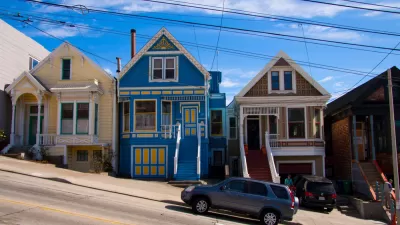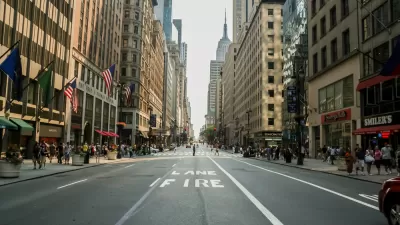With the New York State legislature expected to pass a tolling plan for Manhattan early next week, the Chronicle's Rachel Swan reports on the unlikelihood of a similar plan being adopted in San Francisco or any city in the Golden State.

One of the key reasons that cordon area congestion pricing appears likely to pass the New York State legislature on or before April 1, the state budget deadline, is the need for revenue to address the city's ailing subway system. "Though state leaders have not ironed out details, they had reached consensus on [March 25] that the plan was necessary to help pay for much-needed repairs to the city’s beleaguered subway system," report Jesse McKinley and Winnie Hu for the New York Times.
One congestion pricing plan backed by the governor and mayor is projected to raise about $1 billion annually from fees for driving into a congestion zone spanning Manhattan’s central business district, from 60th Street south to the Battery. That money would, in turn, be used to secure bonds totaling $15 billion for M.T.A. capital projects through 2024.
Rachel Swan, who covers transportation for The Chronicle, took notice of that potential revenue stream in her piece on Wednesday:
But as tempting as that kind of money is to some California politicians and traffic experts, congestion pricing is likely to be a tough sell in San Francisco, Los Angeles or elsewhere in the state anytime soon, even though those cities are considering such proposals.
Like New York, state legislation must pass before cities in California can implement what is technically known as cordon area congestion pricing, urban programs that have been operating successfully in Singapore, London, and Stockholm since 1975, 2003 and 2008, respectively, enabling state legislation is necessary. Pricing the traffic lanes on a street apparently is not the same as pricing the parking lanes on that same roadway.
“There’s just this natural tendency not to like it,” said Assemblyman Richard Bloom, D-Santa Monica. He introduced a bill last year [AB-3059: Go Zone demonstration programs] that would have authorized two congestion-pricing test runs in Northern California, and two in Southern California. The idea: to unclog traffic-snarled streets, reduce air pollution and encourage motorists to spend less time on the road.
“It’s challenging,” said state Sen. Scott Wiener, D-San Francisco, who cosponsored Bloom’s bill last year. “People just aren’t used to paying for the cost of driving,” he added, referring to what it costs to build and maintain roads, not for gas and tuneups
The bill died before its first hearing, hobbled by opposition from the Automobile Club of Southern California [AAA] and the California Trucking Association, among other business and labor groups.
Congestion pricing advocates should not be discouraged, but instead should look at the New York City example. Eleven years ago, congestion pricing died on the New York State Assembly floor due to Democratic opposition. But with new leadership in the legislature and the governor's office, it looks like cordon area congestion pricing will finally be coming to the U.S.
Advocates should find inspiration from recent words from N.Y. Gov. Andrew Cuomo, whose leadership was crucial. Cited from "Cuomo Calls Congestion Pricing The Most Difficult Issue," NY State of Politics:
“Congestion pricing is the greatest opportunity we have had,” Cuomo said in a radio interview on The Brian Lehrer Show on WNYC on March 20. “We have talked about it for 20 years. It is the smartest idea I think for urban development.”
Cuomo has national experience considering he served as Secretary of Housing and Urban Development under President Clinton. The congestion pricing segment in the interview can be found in the second 30-minute segment of (which will appear after the first segment is completed) on The Brian Lehrer Show at 19:50.
Related in Planetizen:
-
Equity Considerations Delay Congestion Pricing in Los Angeles, January 31, 2019
Hat tip to MTC News Headlines.
FULL STORY: Manhattan motorists may face ‘congestion pricing.’ Is San Francisco next?

Study: Maui’s Plan to Convert Vacation Rentals to Long-Term Housing Could Cause Nearly $1 Billion Economic Loss
The plan would reduce visitor accommodation by 25,% resulting in 1,900 jobs lost.

Alabama: Trump Terminates Settlements for Black Communities Harmed By Raw Sewage
Trump deemed the landmark civil rights agreement “illegal DEI and environmental justice policy.”

North Texas Transit Leaders Tout Benefits of TOD for Growing Region
At a summit focused on transit-oriented development, policymakers discussed how North Texas’ expanded light rail system can serve as a tool for economic growth.

Paris Bike Boom Leads to Steep Drop in Air Pollution
The French city’s air quality has improved dramatically in the past 20 years, coinciding with a growth in cycling.

Why Housing Costs More to Build in California Than in Texas
Hard costs like labor and materials combined with ‘soft’ costs such as permitting make building in the San Francisco Bay Area almost three times as costly as in Texas cities.

San Diego County Sees a Rise in Urban Coyotes
San Diego County experiences a rise in urban coyotes, as sightings become prevalent throughout its urban neighbourhoods and surrounding areas.
Urban Design for Planners 1: Software Tools
This six-course series explores essential urban design concepts using open source software and equips planners with the tools they need to participate fully in the urban design process.
Planning for Universal Design
Learn the tools for implementing Universal Design in planning regulations.
Smith Gee Studio
Alamo Area Metropolitan Planning Organization
City of Santa Clarita
Institute for Housing and Urban Development Studies (IHS)
City of Grandview
Harvard GSD Executive Education
Toledo-Lucas County Plan Commissions
Salt Lake City
NYU Wagner Graduate School of Public Service





























